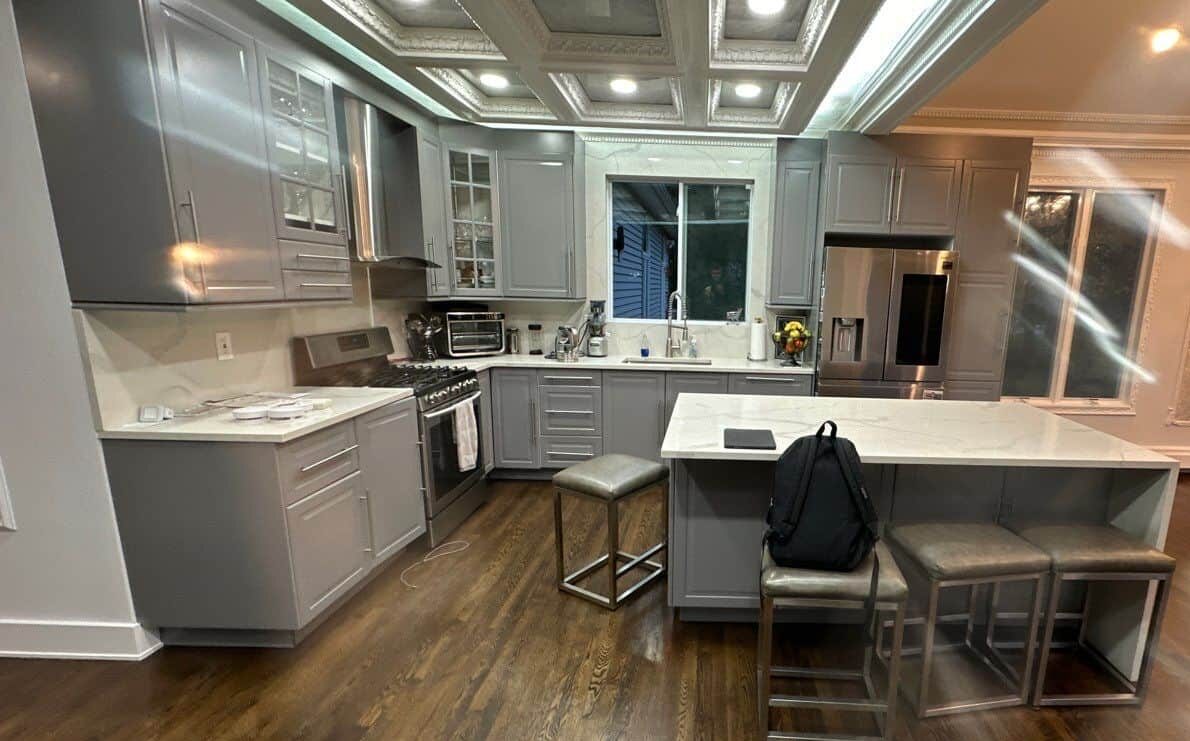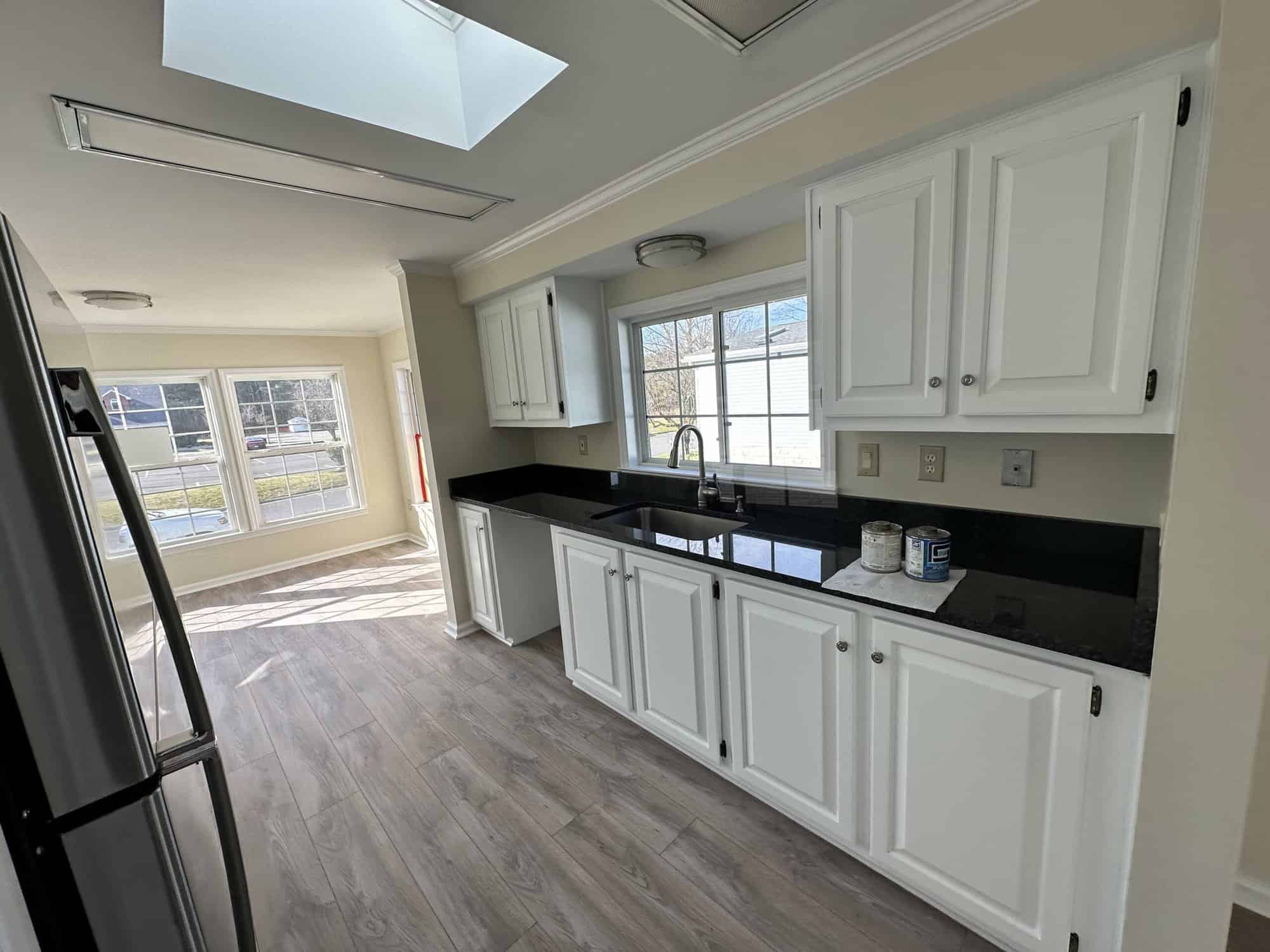Interior house painting can instantly transform your home’s appearance, and one crucial aspect to consider is cleaning cabinets before painting. As an experienced cabinet painter in Manchester, NJ, we understand that a well-prepared surface is the key to a smooth, durable finish.
This blog will guide you through the process, ensuring your cabinets are flawlessly prepped for painting.
Key Takeaways:
- Properly cleaning cabinets before painting ensures a smooth finish, prevents paint issues, and enhances the overall durability of the project.
- Prepare your workspace by clearing items, protecting surfaces, and gathering essential cleaning supplies like soap, sandpaper, and safety equipment.
- Assess cabinet condition, identify the right cleaning method, and remove doors and hardware for better access and results.
- Use the appropriate cleaning solutions based on cabinet material, such as mild soap, TSP, or homemade natural cleaners for safety.
- Sanding, filling holes, priming, and masking areas are crucial for a professional-looking and long-lasting cabinet finish.
Preparing Your Workspace for Cabinet Cleaning
Before you start cleaning cabinets before painting, it’s important to set up a clean and organized workspace. This makes the process easier and prevents dust or debris from interfering with your painting. Begin by removing kitchenware, appliances, and decor from the cabinets. Clearing the area ensures you have easy access to every nook and cranny.
Next, protect your countertops, floors, and other surfaces with drop cloths or newspapers to shield them from cleaning residues or paint splashes. You’ll also want to gather essential cleaning supplies like soap, trisodium phosphate (TSP), sandpaper, and microfiber cloths. Ensuring that safety equipment—such as gloves and masks—is ready will keep you protected, especially when using strong cleaning agents.
Important Tip: Pay attention to ventilation! Open windows and use fans to keep air circulating, especially if you use products that emit fumes.
Assessing Cabinet Condition Before Cleaning
Before cleaning cabinets before painting, could you look at their condition? Identifying the cabinet material, like wood, laminate, or MDF, helps determine which cleaning method to use. For example, wood cabinets might need a gentle cleaning solution, while laminate may benefit from a stronger all-purpose cleaner. This step also helps identify any damage, loose hardware, or peeling paint that needs to be addressed before proceeding.
Removing Cabinet Doors and Hardware
For the best results, a cabinet painter always removes cabinet doors and hardware before cleaning cabinets before painting. This provides better access to the surfaces, allows for more thorough cleaning, and prevents accidental damage. A screwdriver to remove doors, hinges, and handles will ensure cleaner edges and a more professional-looking finish.
Choosing the Right Cleaning Solutions
The choice of cleaning solution can make or break your project. Using the wrong products could damage the cabinet’s surface, affecting the paint’s adhesion. Here’s a breakdown of effective cleaning solutions:
- Soap and Water: A mild soap solution is great for basic cleaning, especially on wood cabinets. Use a sponge or soft cloth to remove dirt and grime gently.
- Trisodium Phosphate (TSP): If the cabinets have grease buildup, TSP is an excellent cleaner. Mix it according to the instructions, apply it to the surface, and wipe it down with a damp cloth.
- Homemade Cleaners: A mixture of vinegar and water can be a natural degreaser for those who prefer an eco-friendly approach.
Cleaning Cabinets Before Painting: The Step-by-Step Process
Now, let’s dive into the detailed cleaning process that every professional cabinet painter in Manchester, NJ, follows to prepare cabinets for painting.
- Remove Dust and Debris: Use a microfiber cloth to wipe away dust. This ensures that cleaning solutions don’t trap dirt on the surface.
- Apply the Cleaning Solution: Choose the appropriate cleaner and apply it depending on your cabinet material. For stubborn grease spots, let the solution sit for a few minutes before wiping.
- Scrub Stubborn Stains: Use a soft-bristle brush or sponge to scrub areas with tough stains. Be gentle to avoid scratching the surface, especially on wood cabinets.
- Rinse and Dry Thoroughly: After cleaning, rinse the cabinets with a damp cloth to remove any residue from the cleaning solution. Then, dry them thoroughly using a soft, clean towel. Proper drying is crucial—any remaining moisture can interfere with paint adhesion.
Preparing Cabinets for Painting
Now that cleaning cabinets before painting is complete, it’s time to prep the cabinets for the actual painting process. This step includes sanding, filling holes, applying primer, and masking off areas.
Sanding for Better Paint Adhesion
The most important step for a cabinet painter is sanding the cabinets. Lightly sand the surfaces with 220-grit sandpaper to create a texture for the paint to adhere to. Remember to sand in the direction of the wood grain to avoid scratches. After sanding, use a microfiber cloth to wipe away any dust.
Fill Holes and Repair Imperfections
To achieve a flawless finish, fill any dents, holes, or imperfections with wood filler. Once it’s dry, lightly sand the area for a smooth surface. This enhances the final look and extends the paint’s durability.
Apply Primer for a Professional Finish
Applying primer is a must before painting. It seals the cabinet surface, prevents stains from bleeding, and enhances paint adhesion. Use a high-quality primer that suits your cabinet material, whether wood or laminate. This crucial step ensures a long-lasting paint job that looks professional.
Masking Areas to Protect from Paint
Masking is essential to avoid paint splatters and keep edges crisp. Use painter’s tape along hinges, handles, and where cabinets meet walls. A careful masking process makes a significant difference in the final appearance of your cabinets.
Final Tips for a Successful Cabinet Painting Project
- Select the Right Paint: Use high-quality, water-based acrylic or alkyd paints for cabinets. Opt for a satin or semi-gloss finish for a durable, easy-to-clean surface.
- Maintain a Clean Workspace: Keep your area clutter-free to reduce accidents and organize supplies. Wipe down surfaces regularly during the project.
- Ventilation: Always ensure proper ventilation during painting to minimize exposure to fumes.
- Cleaning Up: After painting, thoroughly clean your workspace and dispose of leftover materials properly. Wipe off any paint splatters to maintain a neat appearance.
Ready to Transform Your Cabinets? Call the Experts!
Cleaning cabinets before painting is crucial in achieving a professional, long-lasting finish. By assessing the cabinet condition, using the right cleaning solutions, and following proper preparation techniques, your cabinets will be ready for their stunning new look.
As a cabinet painter in Manchester, NJ, ProEdge Painting is here to make this process hassle-free. We serve all of Orange County and Los Angeles County, providing top-notch cabinet painting services that breathe new life into your home.
Need help with your cabinet painting project? Contact ProEdge Painting today for a FREE estimate! Visit our location pages for more information about our services in Toms River, Brick, Manchester, NJ, and the surrounding New Jersey suburbs, or call us at (732) 402-0036. Let us bring your vision to life with our professional painting expertise!


